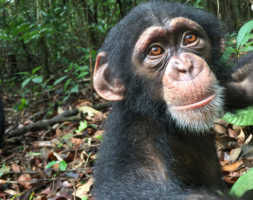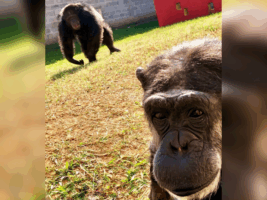North-American drama: 612 chimps are between life and death
 Ken was born in an Air Force base in the North-American state of New Mexico in 1982. He was taken out of his mother as soon as he was born and 12 hours after his birth he was subjected to his first extraction of blood. During the next three years, he was a guinea pig in studies in the laboratories of the CDC (Center for Disease Control) in Atlanta and Phoenix. He was infected with Hepatitis C using the serum of another chimpanzee who was infected and with Hepatitis A through human feces. In 1993, he was infected with the HIV virus.
Ken was born in an Air Force base in the North-American state of New Mexico in 1982. He was taken out of his mother as soon as he was born and 12 hours after his birth he was subjected to his first extraction of blood. During the next three years, he was a guinea pig in studies in the laboratories of the CDC (Center for Disease Control) in Atlanta and Phoenix. He was infected with Hepatitis C using the serum of another chimpanzee who was infected and with Hepatitis A through human feces. In 1993, he was infected with the HIV virus.
Ken was retired from medical research in 1996, after suffering 77 anesthetic procedures to draw blood and do biopsies. After being retired, he went to Alamogordo Primate Center, of Air Force. During a routine examination in 2005, it was discovered a deficit of a protein in his blood, which later caused swelling of his scrotum and abdomen.
In June 2010, after 14 years of retirement, Ken and 200 other companions were ordered to return to active in medical research, being transferred to the National Primates Research Center of the Southwest, in San Antonio, Texas.
This case of medical abuse and torture of chimpanzees is just one among hundreds that await an end by a decision of the U.S. Government. There are 612 chimpanzees, which are owned by NIH – National Institute of Health, which is an official body that directs and funds scientific research in healthcare in the United States.
A bill is pending in the U.S. Congress to end torture in medical researches with chimpanzees in the country. While the debate rages in the legislative, the executive tries to buy time to allow NIH to continue using chimpanzees in medical research, in a suspected collusion with pharmaceutical corporations in the global demand for drugs that generate billions of dollars in profit.
Several organizations, such as Project R & R, NEAVS, Humane Society and GAP Project, have denounced the lack of criteria that NIH uses to manage the chimps it has under control. There is an official sanctuary in the United States – CHIMP HAVEN, in Louisiana, and NIH – rather than help expand Chimp Haven, in order to eventually transfer all chimpanzees under its tutelage in the near future – send them to another Torture Center – the Primate Center in San Antonio, where, at any time, they can be tortured again.
NIH, pressured by the North-American society months ago, requested that the Institute of Medicine commented on the usefulness of primates in medical research, as a way to seem transparent and democratic. But the result was clear: the Institute of Medicine concluded that medical research with chimpanzees did not give positive results as positive and it was not justified maintaining it.
Perhaps there is an economic issue in the decision to send the 200 retired chimpanzees to a medical laboratory, and not to a sanctuary. NIH paid USD 56.30 per day per chimpanzee in Torture Center of San Antonio. In the sanctuary it would pay a 41 per day. This difference yields more than $ 1 million annually, which go into the pockets of the Center for Torture. This center is also generously treated by NIH, which in 2011 awarded a contract to them in the amount of U.S. 19 million over five years, for research only with chimpanzees.
Relations between NIH and Primate Center in San Antonio, Texas, are suspect, since many resources are channeled to this Torture Center, which, apart from chimpanzees, owns hundreds of small primates. Several reports prove irregularities in Primate Center , which have led to heavy fines by the inspectors of the Department that looks after animal welfare the U.S..
Moreover, it is estimated that several unnecessary euthanasia was practiced in chimpanzees, claiming incurable diseases. The median survival of chimpanzees in that center does not exceed 40 years.
The close relations of NIH and the Primate Center date back to 1999, when it was chosen as one of eight national centers of research with apes, and was given a five-year contract of U.S. 27.9 million by NIH. Besides chimpanzees, it has the largest colony of captive baboons in the world, as well as other monkeys, including Brazilian marmosets.
In April 2010, Ken was diagnosed with heart problems by doctors at the Air Force Base, where he was retired. His heart was weak because of the suffering and experiences with him. The recommendation contained in his medical record, before departing for the Torture Center of San Antonio, was “if his the heart stops, do not try to revive him, let him die finally.”
In our hands there is a mission to save him from this terrible foretold death, as well as 611 of their fellow sufferers, who are at the mercy of those who care little for their fate and not have the slightest compassion in their soul to save innocent beings of more sufferings.

 Español
Español
 Português
Português








